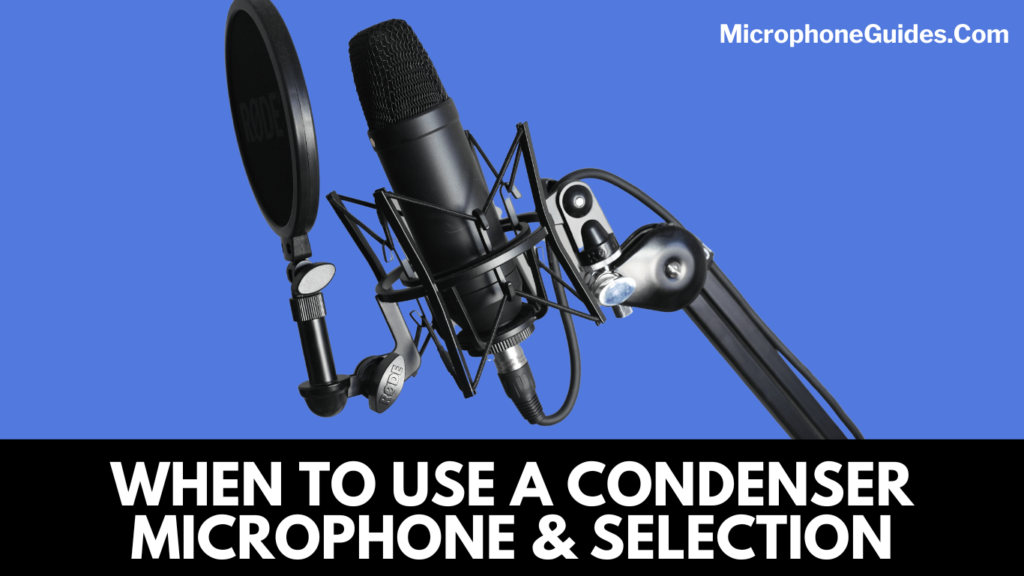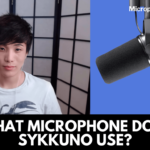The microphone is a device that works like a transducer and transfers mechanical sound energy into electrical sound waves. But there are plenty of types of microphones that vary in their working as well as their pattern of producing sound. That is why they are available as dynamic, ribbon, and condenser microphones.
All these three main types are different from each other in their frequency response, transducers, directional pattern, and working principle.
If we take the example of a condenser microphone that works like a capacitor, then it has some distinctive features like a high-frequency response and side address polar pattern, and these features decide the purpose of a condenser microphone. It may seem confusing to you, but we will try to sum up the main highlights of the purpose of a condenser microphone in an understandable way.

After reading this article, you will be able to know when to use a condenser microphone to make your recordings the best. Let’s go ahead without further delays!
When Does Condenser Microphone Work at Its Best?
Condenser microphones are a special type of microphones that are designed sensitively means they are fragile in their structure as well as their working. Unlike dynamic microphones that do not need any power supply, these microphones work like a capacitor which is why they require phantom power to work.
And when we talk about the conditions when it is used the most, then the quieter environment of the studios should be top mentioned. In such environments, clear sound with high accuracy is needed, and a condenser microphone provides you with an opportunity to record the perfect professional sound.
With their added technology, it exhibits filters to reduce the noise and eliminates the unwanted audio that could bring imperfection in the recorded sound. In addition to this, it has an interchangeable polar pattern that helps in recording all types of sound pitch.
The lightweight membrane of the diaphragm of this microphone makes it more sensitive to sound, and it records the vocals of most acoustic instruments, especially the drum and guitar. But this is a summary of the use of a condenser microphone. We need a bit more explanation to make the concept clear for you. So scroll down to get a deeper insight!
The understanding will be easier for you when you know the condenser microphones with their types. So here are the two main types of condenser microphones based on the size of the diaphragm:
- Small diaphragm condenser microphone
- Large-diaphragm condenser microphone
What is a Small Diaphragm Condenser Microphone?
A small diaphragm condenser microphone, as the name suggests, has a smaller, thinner, and pencil-shaped diaphragm membrane. Now here is a use of a small diaphragm condenser microphone!
- Records Original Sound
The small diaphragm condenser microphones are the best way to record the sound without any additional colorings.
- Best for Orchestral Instruments
The orchestral instruments, for example, brass, bass, strings, ensemble, etc., are the best recorded with a small diaphragm condenser microphone. So if you are a classical singer and want to succeed in the field, then do try these microphones. Moreover, the post-processing, editing, and mixing of the sound become easier with this type of condenser microphone.
- Creates Balance for the Piano Tone
A piano contains several different octaves, and it is quite hard to understand the basics of piano, so the recording also seems difficult. But small diaphragm condenser microphones are a perfect choice to use with a piano as they deal with the lows, mids, and highs of the tones with incredible balance.
- Suitable for Drum Overheads
The small diaphragm condenser microphone deals with the transient sound of the drum overheads so nicely. Although a drum creates a very explosive sound when you listen to it in a recording, then it never makes you irritated.
What is a Large Diaphragm Condenser Microphone and When to Use It?
As the name of this type of condenser microphone depicts, they have a bigger and side-addressed diaphragm. The large diaphragm microphones are placed near and parallel to the source to capture the best sound possible. They are best used in these certain situations:
- Great for Vocal Recordings
For vocal recording, these microphones are the best decision to use. As these are highly sensitive in their function, that is why record the vocals with more details. In other words, it is accurate to say that large diaphragm condenser microphones are famous for picking the low-end frequencies so that the singers can be judged properly.
- Better to Get Low-End Sounds
Acoustic instruments like bass guitar, saxophone, piano, and trumpet need sensitive microphones to record every detail of the music, but we should not overlook the low-end sounds, so to use these microphones, the large diaphragm microphones are the best option. But the point to ponder here is that, in this situation, both types of condenser microphones can be used alternatively as the results will not be affected.
- Record Vibrant Sound with the Solo Acoustic Guitars
A large diaphragm created an alive sound by editing the audio on its own. You can also relish the adjustments done with such a microphone, especially by using a solo acoustic guitar.
The only background of this condenser microphone is its sensitivity toward the voice, which is why it sometimes records audio that should not be recorded. That is why it needs a quieter and more controlled studio environment to work properly, and you also need a mixer with phantom power to work with the condenser microphone.
Final Statement
Condenser microphones are famous for discarding unwanted and abrasive sounds and picking subtle sounds nicely. It is one of the most desired equipment for studio recordings with high accuracy and great details. Hopefully, you have a better understanding of when to use a condenser microphone and what instruments are appropriately used with these microphones. Adieu!
William Souza Here, I Am Sound Specialist, Have Trained Many Musicians And Singers. I Write Blog Contents About Sound, Music, Microphone Reviews, Speaker Reviews, Sound Card Reviews And All About Sound/Music Reviews And Instruction. I Am Writing On This Blog MicrophoneGuides.com As On My Experience And Will Update More Information & Review About Different Microphones For Different Users.









